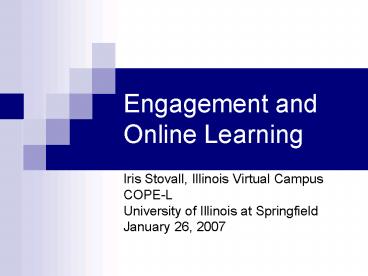Engagement and Online Learning PowerPoint PPT Presentation
1 / 19
Title: Engagement and Online Learning
1
Engagement and Online Learning
- Iris Stovall, Illinois Virtual Campus
- COPE-L
- University of Illinois at Springfield
- January 26, 2007
2
What is Student Engagement?
- Time on task?
- Students willingness to participate in class
activities - Cognitive, behavioral, affective indicators
http//www.ericdigests.org/2005-2/engagement.html
3
What do Instructors Observe?
- Those that are engaged show sustained behavioral
involvement in learning activities accompanied by
a positive emotional tone - Those that are not engaged are disaffected,
passive, do not try hard, and give up easily when
faced with challenges
http//www.ericdigests.org/2005-2/engagement.html
4
Who Benefits from Engagement?
- Everyone
- Those students who come to college less well
prepared academically or from historically
underrepresented groups tend to benefit from
engagement in educationally purposeful activities
even more than their peers do.
http//www.insidehighered.com/news/2006/11/13/nsse
5
Measuring Engagement
- National Survey of Student Engagement (NSSE)
focused on distance education for 2006 - Based on student questionnaires (self reporting)
- Level of challenge
- Active and collaborative learning
- Student-faculty interaction
- Enriching educational experiences
- Supportive environment
- UIS students participate
6
Measuring Engagement
- Distance learning students outperform or perform
on par with on-campus students on measures
including level of academic challenge
student-faculty interactions enriching
educational experiences and higher-order,
integrative and reflective learning and gains in
practical competence, personal and social
development, and general education. They
demonstrate lower levels of engagement when it
comes to active and collaborative learning.
http//www.insidehighered.com/news/2006/11/13/nsse
7
Measuring Engagement
- Other ways to measure student engagement include
instructor ratings and checklists
8
Why Do Students Engage?
- Motivation, either extrinsic or intrinsic, plays
a large role. - Intrinsically motivated students earn higher
grades and test scores, are better adjusted to
school, are more likely to feel confident about
their ability to learn new material, are more
likely to engage in tasks that are moderately
challenging, retain information better and are
more likely to be life long learners.
http//www.nwrel.org/request/oct00/textonly.html
9
Motivating Online Students
- Part art, part science
10
Science of Motivation Building Course Structure
- Ensure expectations are clear and consistent
- Along with feedback, provide opportunity to
discuss how assignments were graded - Respond positively to student questions
- Make sure large, complex tasks are broken into
smaller, achievable components
11
Science of Motivation Building Course Structure
- Promote mastery learning, when possible
- Provide feedback on assignments as soon as
possible - Evaluate students according to your rubric or
standards, and not by comparing their work to
that of other students
http//www.nwrel.org/request/oct00/textonly.html
12
Science of Motivation Course Content
- Assignments should contain real-world aspects
- Help students to see ways the assignment relates
to work or life experiences - Allow students to choose
- Arouse curiosity about the subject
- Assign collaborative projects where students can
share what they know with other students
http//www.nwrel.org/request/oct00/textonly.html
13
Art of Motivation
- If the science is in place, you are freer to
experiment - Be who you are
- Show your passion
- Become an emotional writer
14
Determinants of Engagement Study
- Graduate students in Information Systems Course
- Examined asynchronous discussion forum messages
- What interactions generate the most student
engagement? - Counted the number of times a particular message
was read
http//www.ce.ucf.edu/asp/aln/cfp/presentations/11
62852287092.ppt
15
Determinants of Engagement Study
- Messages categorized
- Initiator
- Facilitator (middle-man with social and teaching
behavior types) - Contributor
- Knowledge-elicitor (question asker)
- Vicarious-acknowledger (me-too)
- Complicator (reframer)
- Closer (synthesizer)
- Passive Learner (freeloader)
16
Message Type With Most Engagement
- Knowledge-elicitor messages generated 24 reads
per message versus 16.8 reads for all messages - Knowledge-elicitor students generated engagement
within the class
17
Other Factors Related to Engagement?
- Length of message - no
- Frequency of posting - no
- Position of message no (for messages posted
early) - Type of participant - no
18
Implications for Online Courses
- Students may value knowledge of and learn from
other students - Students peers can stimulate engagement (not
only the instructor) - Instructors should model best practices in the
discussion forum and discourage me too posts
19
Engagement
- Motivation is key
- Build your course based on what is know about the
science of design - Become an artist in the online classroom

